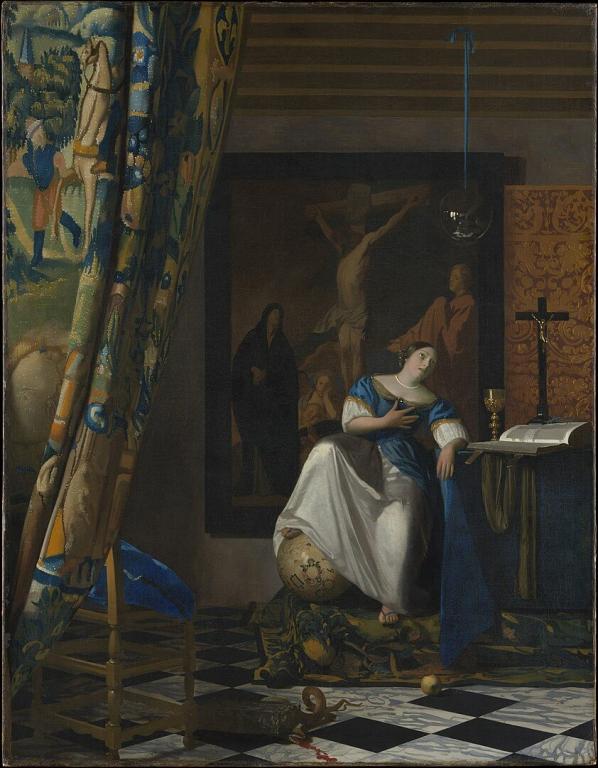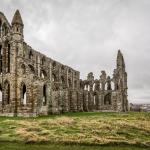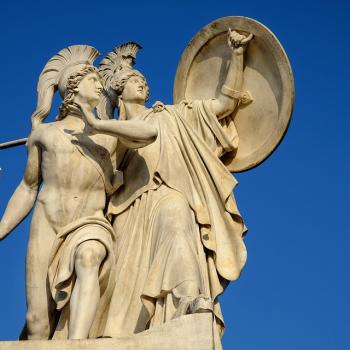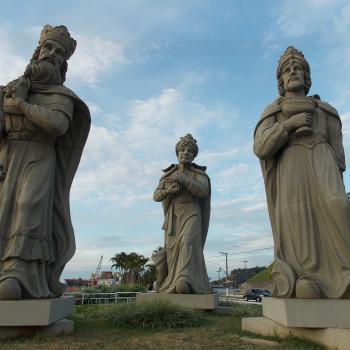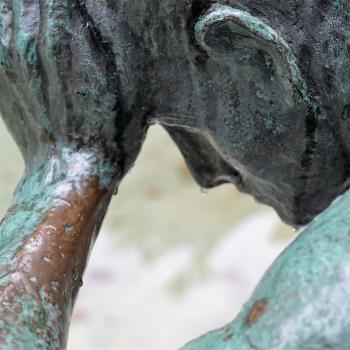Many who know about 17th-century Dutch artist Johannes Vermeer think first of his “The Girl with a Pearl Earring,” that lovely portrait of a young girl looking over her shoulder. Or perhaps they think of “The Milkmaid,” capturing the woman standing in the light of a window before a kitchen table. Both are gentle, captivating pieces that play with light and soft shadows, and they exude a spirit of peace and simplicity.
This piece is entirely different. It’s complex, a bit ferocious, and demanding in its details. Unlike most of his work, this piece represents a unique genre of allegorical art. As with allegorical literature, allegorical art uses its elements to symbolize spiritual or moral concepts. Vermeer has packed this painting with symbols, inviting us into a deep consideration of the elements of our faith. Look for these clear allegorical elements: the stone crushing the snake, the apple, the open book, the chalice, the draped stole, the globe, the clear orb, and the curtain pulled to the side.
In reading an allegorical work, whether written or visual, the reader herself has to bring meaning to the symbols. As an Allegory of Faith, we can surmise some “messages” that Vermeer wanted to impart, but the beauty of allegory is its evocative power. It isn’t a sermon; it’s a story. You, the viewer, need to find your way into this story.
The curtain is pulled back, as though this is a tableau vivant, a staged scene for our contemplation. It suggests a drama, a silent, still portrayal of the central act of a play. At the center of the painting, the woman clutches her breast and looks upward, to the clear globe. Her posture portrays a tension between power—her foot resting on the world—and humility—her upward glance of petition. It’s as though she knows that the victory of her faith is sure, but the way is long. Her focus on the clear orb, which reflects just a bit of her dress and the light from the windows that we cannot see, invites us to speculate a bit on the mystery of faith—seeing, and yet not seeing. Seeing through, seeing beyond, seeing only a reflection. We see as in a riddle, Paul says (1 Cor 13.12).
Yet there are many “helps” along this long journey of faith. Our disastrous choices of sin, like the fallen apple, have allowed a snake in the room, an evil, slithering presence that has invaded our inner lives and threatens us, but, thanks be to God, that Cornerstone has fallen on it, crushing its head. At hand, the scriptures and the Chalice, backed by the crucifix, offer us the light and life of Jesus, the Word of God and the Cup of Salvation.
Behind the woman is a large painting, a replica of a painting by a fellow 17th-century Dutch artist, Jacob Jordaens. Vermeer’s choice to repaint this piece of art as the backdrop of his own Allegory suggests that the Crucifixion is the primary setting of this tableau. Here Jesus, dying on the Cross, is accompanied by several characters, each of whom “speaks” in this tableau. John, in red, stands to the right and points at Mary whose eyes, like ours, are on Jesus. At the foot of the cross we see the other women, including Mary of Bethany in prayer, Mary Magdalene, Salome, and others. The light is both on Jesus and coming from him, though in the Vermeer backdrop all this is quite muted. It’s the whisper behind the woman of Faith.
Now stand back from this painting again, and just connect in your mind with all the symbols of Jesus. Jesus, the Chief Cornerstone, precious and sure and marvelous. Jesus, the Seed of Eve who crushes the head of the serpent. Jesus, the Word; Jesus, the Cup; Jesus, the High Priest; Jesus, the Light of the World; Jesus, Crucified for us.
This painting is an Allegory of Faith. You are the woman sitting in this scene. Does this speak to your journey of faith? Where are your eyes? Is the Word always open before you? Is the backdrop of your life—the setting of your whole world—the Crucifixion of Jesus, the Lamb of God who takes away the sins of the world?


